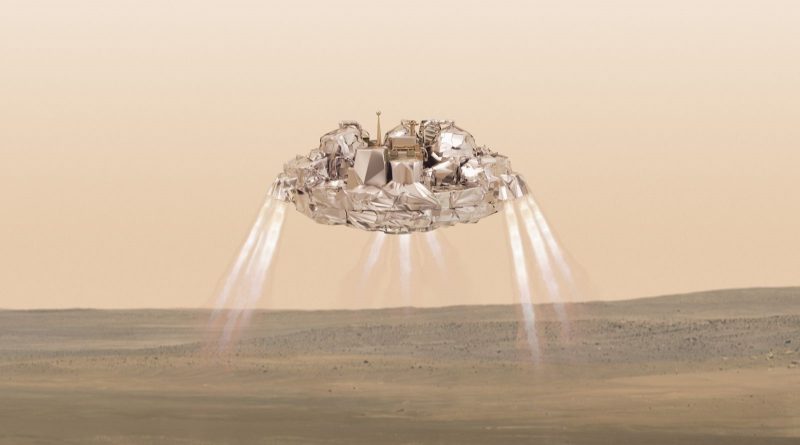ExoMars 2016 on final Approach to Landing / Orbit Insertion after last Course Correction
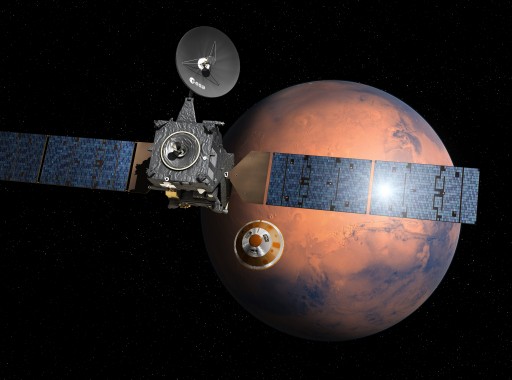
The ExoMars 2016 spacecraft is on the final approach to its arrival at Mars after conducting a final adjustment to its flight path to set the stage for Sunday’s planned separation of the Schiaparelli lander from the Trace Gas Orbiter ahead of the big day on Wednesday.
Schiaparelli could become the first European spacecraft to make a successful landing on Mars, a feat to date only achieved by NASA. The critical landing sequence will take only six minutes that represent the lander’s primary mission objective – a demonstration of a Mars entry vehicle, supersonic parachute and propulsive descent ahead of a short drop to the surface.
>>Live Coverage & Regular Updates
In parallel to Schiaparelli’s dramatic landing – several hundred Kilometers higher, the Trace Gas Orbiter will fire its main engine for more than two hours to insert itself into orbit around Mars to become Europe’s second Mars orbiter, following in the footsteps of Mars Express that has been in Mars orbit since 2003.
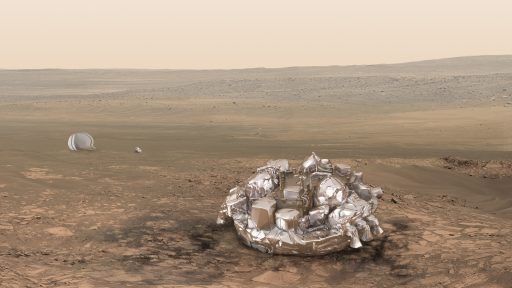
Schiaparelli, also known as Entry, Decent & Landing Demonstrator Module (EDM), will pave the way for the ExoMars 2020 mission that will deliver to the surface of Mars the first European rover and a Russian-built surface platform. The 577-Kilogram vehicle is outfitted with extensive instrumentation to capture data during atmospheric entry and the radar-guided descent. Only powered by non-rechargeable batteries, EDM will stay alive for around four days after landing, employing an environmental sensor suite to capture weather and dust parameters relevant for future missions.
While EDM’s mission is only a few days in duration, its orbiting companion, the Trace Gas Orbiter or TGO, is in for the long-haul – set to complete a science mission of five years to characterize the trace gases present in the Martian atmosphere with four instruments built in Europe and Russia. TGO will take a detailed inventory of the Martian atmosphere, identifying what trace gases are present and studying their isotopes, seasonal variation and geographical sources/sinks of the gases.
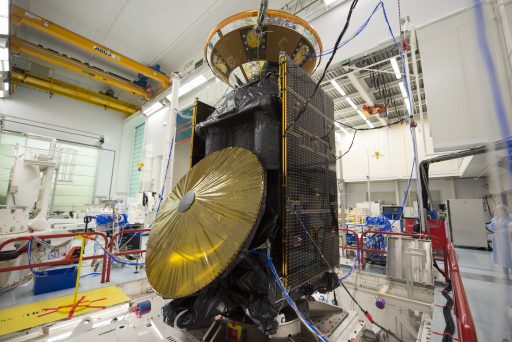
The 4,330-Kilogram ExoMars 2016 spacecraft was sent on its way on March 14 aboard a Proton-M/Briz-M launch vehicle that performed a multi-orbit ascent mission ahead of injecting the spacecraft into its interplanetary trajectory nearly eleven hours after launch. Successfully sent on its way, ExoMars 2016 went through systems checks before settling in for a relatively quiet cruise phase to Mars.
On July 28, ExoMars fired its S400 main engine for 52 minutes to change its speed by 326.5 maters per second in order to home in on Mars. The Deep Space Maneuver was followed by a second maneuver in September to fine-tune the trajectory and simulate the spacecraft command sequence for the critical Mars Orbit Insertion maneuver.
Earlier this week, the Schiaparelli lander was checked out and received command timelines for its ambitious landing maneuver as well as its entire surface mission, containing the schedule for the operation of its instruments and the data uplink windows when NASA and ESA Orbiters pass overhead to accept the data collected by the surface platform. Also, Schiaparelli’s batteries were conditioned and the landing vehicle was slewed toward the sun to be heated up in order to save heater power during its three-day free flight.
>>ExoMars 2016 Arrival Timeline
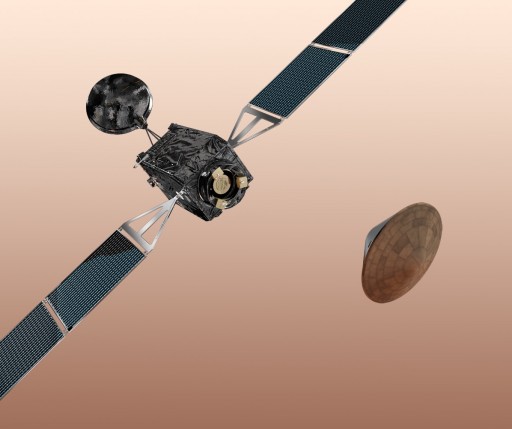
On Friday morning, the various mission support teams at ESA and industry partners were polled for a status and a unanimous GO was given for Schiaparelli’s separation & landing, and TGO’s orbital insertion maneuver per the planned timeline.
At 8:45 UTC on Friday, the spacecraft fired up its thrusters for a very small trajectory correction of 1.4 centimeters per second, nudging the combined orbiter and lander onto the precise atmospheric intercept course to take Schiaparelli to its 15 by 100-Kilometer landing ellipse in Meridiani Planum, close to NASA’s Opportunity rover that has been exploring Mars since 2004.
Separation of the Schiaparelli lander is expected at 14:42 UTC on Sunday, being pushed off at a relative speed of 30cm/s with TGO imparting a 2.75 RPM rotation on the lander for passive stabilization until hitting the atmosphere.
With the lander on its way, TGO is set for a critical course correction twelve hours after dispatching Schiaparelli to change its speed by 10 meters per second and transition from a collision course with Mars to a safe flyby well above the atmosphere.
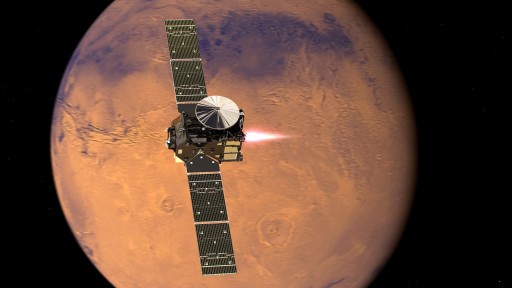
Not much will occur in the two and a half days after the maneuver – Schiaparelli will be in hibernation to save power and the orbiter will receive a last set of instructions from Earth to transition into a special mode for the mission-critical Mars Orbit Insertion.
This spacecraft mode ensures that non-critical problems occurring in any of the orbiter’s subsystems will not stop the orbital insertion for which there is only one attempt once it gets underway.
The sequence of events on Wednesday will be relatively fast paced in the twofold adventure at Mars, 175 million Kilometers from Earth. No intervention from Mission Control will be possible as the one-way signal travel time will be 9 minutes and 46 seconds.
TGO is set to ignite its main engine at 13:05 UTC on a 139-minute braking maneuver that slows the spacecraft by 1,550 meters per second to achieve a highly elliptical orbit around Mars. Mission Controllers will be able to monitor the progress of the burn via Doppler Tracking, but no high-data-rate communications will be possible with TGO throughout the activity.
>>Detailed ExoMars 2016 Landing / Orbit Insertion Walk-through

Schiaparelli powers up 75 minutes ahead of atmospheric entry to calibrate its navigation system and begin sending telemetry that will be recorded by the Trace Gas Orbiter as well as Mars Express which will cover the critical landing maneuver.
Atmospheric entry occurs at 14:42 UTC when Schiaparelli passes 121 Kilometers in altitude, traveling 5.83 Kilometers per second.
Enduring temperatures of 1,750°C, Schiaparelli will be slowed to around 470 meters per second in the Martian Atmosphere before deploying its supersonic parachute to further slow its descent. The heat shield will drop away 7 Kilometers in altitude to give the lander’s Doppler radar an unobstructed view of the surface to begin collecting navigation data.
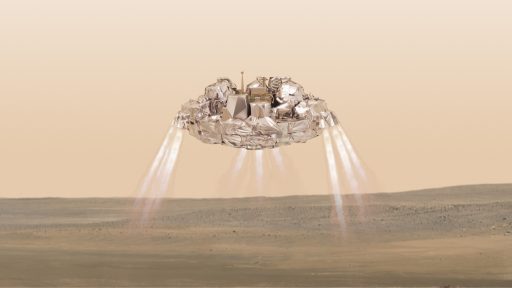
When sensing an altitude of 1.2 Kilometers, the landing platform will cut itself free from the parachute and back shield, firing up nine Hydrazine-fueled thrusters for a rocket-powered descent to the surface. The engines will operate only half a minute, delivering the lander to a position around 1.5 meters above the ground when engine cutoff will be commanded and Schiaparelli will fall to the surface, using a crushable structure to cushion the impact.
Listening in on the lander’s faint signals will be an array of 30 radio telescopes in India which – if successful in detecting the extremely weak UHF signal – would be the first to confirm a successful landing if signals persist after the expected touchdown time of 14:48:11 UTC (14:57:57 UTC Earth-receive time).
Should the ground-based recording campaign be unsuccessful, the next confirmation of landing would come through the data downlinked by Mars Express around 16:30 UTC. NASA’s Mars Reconnaissance Orbiter will pass over Schiaparelli within 90 minutes of landing and could also confirm a good landing should it receive the planned data dump from Schiaparelli.
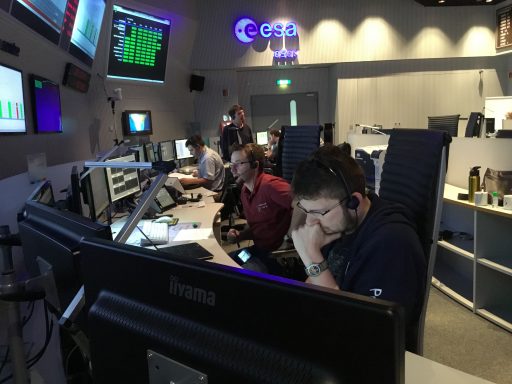
While Schiaparelli’s nail-biting landing only takes six minutes, the tension for the orbiter’s mission team will last for over two hours. TGO will close out its burn at around 15:24 UTC – the actual shutdown time will depend on the measured performance of the main engine.
However, it will take at least one hour of tracking and data analysis to confirm whether TGO arrived in the planned 298 by 95,856-Kilometer orbit.
Schiaparelli’s landing will provide the data needed to deliver Europe’s first Mars rover to the surface to fulfill the second half of the ExoMars mission objectives. While the orbiter detects atmospheric trace gases that are relevant when assessing the past and present habitability of Mars, the 2020 ExoMars rover will be tasked with the search of possible biosignatures.

